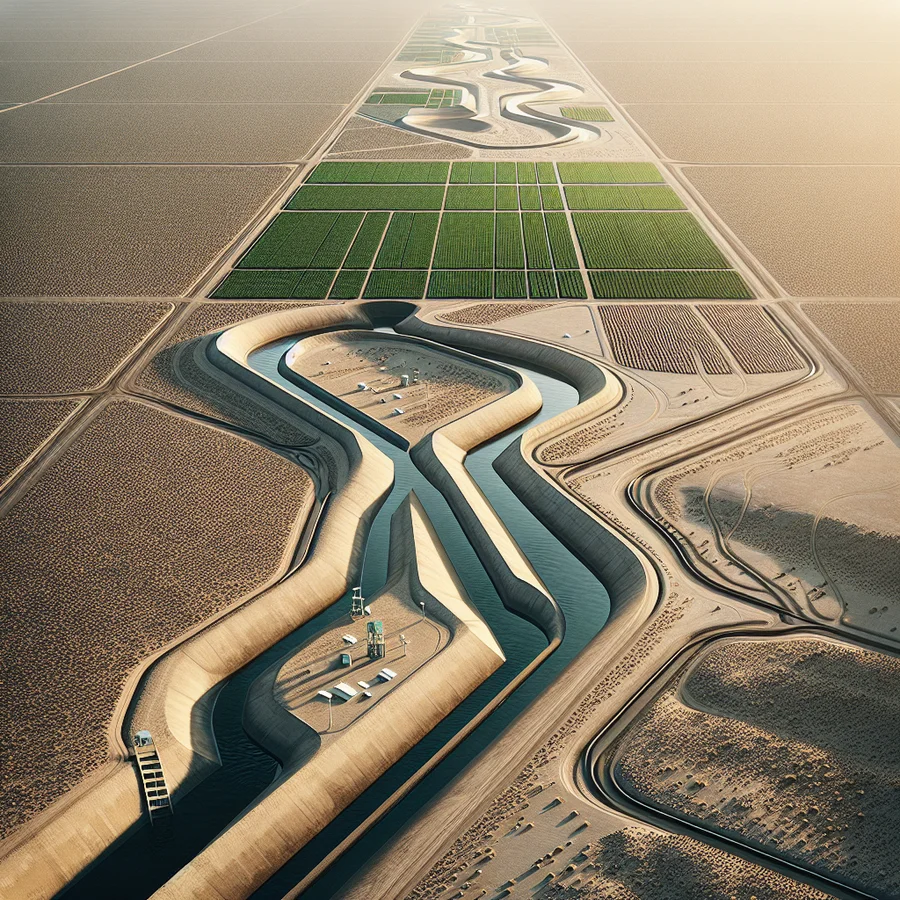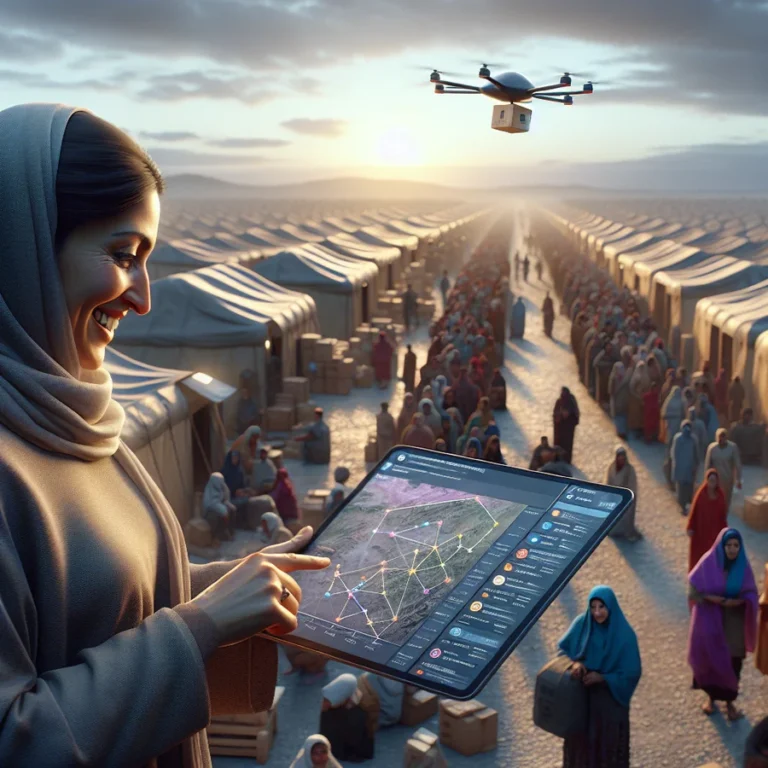AI in Water Management: Optimizing Usage and Reducing Waste
Water is essential for life, but it’s becoming increasingly scarce. Climate change, population growth, and industrial expansion are straining our water resources. Fortunately, Artificial Intelligence (AI) in water management offers innovative solutions to optimize water usage and minimize waste. This guide explores how AI is revolutionizing the way we manage this precious resource, ensuring a more sustainable future for all.
Imagine using technology to predict water demand, detect leaks in pipelines, and optimize irrigation in agriculture. That’s the power of AI! By leveraging AI, we can make smarter decisions about water allocation, improve water quality, and respond quickly to water-related crises. Let’s dive into the exciting world of AI in water management and discover how it’s shaping a more water-secure future.
The Role of AI in Transforming Water Management
Traditional water management methods often struggle with the complexity of data and the need for quick, accurate decisions. AI offers a powerful solution by processing vast amounts of data, identifying patterns, and generating precise predictions. This leads to better water quality monitoring, optimized consumption, and efficient water systems.
AI’s ability to improve forecasting accuracy and respond rapidly to environmental changes is a game-changer. Machine learning models can analyze precipitation levels, temperature, soil moisture, and reservoir levels to predict water availability. This allows for informed decisions on water allocation and crisis management.
How AI Enhances Environmental Monitoring for Water Resources
AI significantly improves environmental monitoring, especially for water resources. Remote sensing technology and AI algorithms analyze data from satellite images and sensors. This helps track changes in ecosystems and monitor the health of oceans, providing real-time data for conservation efforts. This data is invaluable for understanding the impact of human activities on the environment.
AI’s Impact on Optimizing Energy Consumption in Water Systems
AI plays a crucial role in refining energy consumption within water systems. AI algorithms forecast demand and supply shifts, enabling smart grids to distribute power effectively. This reduces waste and integrates renewable energy options. AI-driven systems in buildings and industrial processes can also significantly reduce energy consumption by adapting to usage patterns, which lowers carbon footprints. You can see a similar application in AI smart energy management.
Key Applications of AI in Water Management
AI is being applied across various aspects of water management, from predicting demand to optimizing distribution. Here are some key applications:
- Demand Forecasting: Predicting future water needs based on various factors.
- Water Quality Management: Monitoring and maintaining water quality using sensor data and AI algorithms.
- Water Distribution Optimization: Improving the efficiency of water distribution networks.
- Leak Detection: Identifying and addressing leaks in water pipelines.
- Sustainable Agriculture: Optimizing water usage in agriculture through precision irrigation.
Let’s explore each of these applications in more detail.
AI-Driven Precision Agriculture: A Case Study
Consider AgroAI, an agritech startup revolutionizing farming through AI and IoT. Founded in 2018, their goal is to make agriculture more eco-friendly and efficient. They partner with farmers and researchers to develop solutions for critical agricultural challenges.
The Challenge: Enhancing crop yields while minimizing environmental impacts like water overuse and chemical runoff.
The Solution: AgroAI developed an AI-driven precision agriculture platform:
- IoT sensors collect real-time data on soil hydration, nutrient content, and climate conditions.
- AI algorithms analyze data and provide precise irrigation, fertilization, and pest control recommendations.
- A user-friendly app allows farmers to monitor crops and receive alerts.
The Result: Reduced water usage by up to 25%, decreased chemical runoff by 30%, and increased crop yields by 20%.
Demand Forecasting with AI
Predicting water demand is crucial for effective water resource management. It allows for better planning, optimized resource allocation, and waste prevention. AI, with its machine learning algorithms, provides a powerful tool for this purpose.
Machine learning algorithms analyze historical data and consumption patterns to forecast future water needs. They consider factors like weather, population growth, and industrial needs. This allows for more accurate predictions and better resource management.
The Role of Machine Learning in Predicting Water Demand
Machine learning algorithms are essential for predicting water demand. They analyze historical data and past consumption patterns. This provides more precise forecasts of future water needs. These algorithms incorporate various data sources, including:
- Precipitation levels
- Air temperature
- Seasonal variations
- Demographic changes
- Economic and social factors
By analyzing rainfall trends and climate fluctuations, AI can estimate the required water supply for the upcoming months. This enables water resource managers to plan more confidently.
Scenario Simulation for Climate Change and Population Growth
AI can simulate different scenarios and assess the impact of climate change and population growth on water demand. Climate variations can lead to reduced precipitation or increased temperatures, affecting water demand. AI can model these changes and predict the best possible scenarios for ensuring adequate water supply. This allows for more efficient and accurate resource allocation.
Optimizing Resource Usage and Preventing Wastage
Accurate water demand forecasting minimizes excessive consumption during peak demand periods. During dry seasons or low-rainfall periods, optimizing irrigation programs in agriculture and managing industrial water usage can reduce water wastage. This ensures the sustainable management of limited resources. Water demand forecasting also aids decision-making at national and local levels. If forecasts indicate an increase in future demand, storage and distribution plans can be adjusted more effectively. These predictions are valuable for managing water crises like droughts and floods.
Water Quality Management Using AI
Maintaining water quality is vital for human health, natural ecosystems, and efficient water resource use. AI can effectively detect pollution and address water quality issues by analyzing data from sensors and sampling processes.
Sensor systems measure parameters like pH, temperature, dissolved oxygen, and pollutants. AI processes and analyzes this data to identify anomalies or sudden changes in water quality. This allows for quick responses and reduces the risk of widespread contamination. For more on data handling, see “DeepSeek Data Privacy.”
Analyzing Sensor Data for Pollution Detection
AI analyzes data collected from various sensors to detect pollution. In many regions, sensor systems are installed to measure parameters such as:
- pH
- Temperature
- Dissolved oxygen levels
- Chemical and microbial pollutants
These sensors continuously collect real-time data and transmit it to databases. AI can process and analyze these large datasets to identify anomalies or sudden changes in water quality.
Predicting Future Pollution Events
AI can predict potential future pollution events by analyzing large-scale data patterns. By examining trends in water quality and environmental factors, AI can forecast pollution risks arising from heavy rainfall, rising temperatures, or industrial changes. These predictions allow managers to implement preventive measures before a crisis emerges.
Identifying Pollution Sources
AI can assist in identifying the primary sources of water pollution. By analyzing sensor data across different points in the water distribution network, AI systems can pinpoint the exact location of contamination and simulate its path. This precise identification enhances water treatment processes, ensuring that purification operations are conducted more effectively and efficiently.
Optimizing Water Distribution with AI
Efficient water distribution is crucial for minimizing waste and maximizing resource utilization. AI algorithms can analyze data, simulate scenarios, and predict network conditions to improve water distribution efficiency.
AI can optimize water pressure and flow, detect leaks, and propose effective scheduling for water distribution. This reduces water loss, lowers energy costs, and enhances the sustainability of water systems.
Pressure and Flow Optimization
AI algorithms can optimize water pressure and flow in distribution networks by analyzing data collected from sensors and monitoring systems. Smart systems can use real-time pressure data from different network points to identify areas with significant pressure drops or potential leaks and automatically adjust pressure levels in these areas. This prevents water loss within the network and ensures optimal resource distribution.
Leak Detection and Management
Leaks in distribution networks are a major cause of water loss. AI algorithms can accurately simulate leak locations by analyzing pressure and flow data, allowing system managers to detect leaks early. These simulations help decision-makers take preventive measures before serious system failures occur.
Reducing Energy and Operational Costs
Optimizing water distribution through AI reduces water loss and lowers energy and operational costs. Water distribution systems often require extensive pumping to maintain adequate pressure, leading to high energy consumption. By optimizing pressure and flow, AI can help reduce excessive energy use and lower the costs associated with water pumping and distribution.
AI for Water Resource Management in Times of Crisis
Efficient water resource allocation is necessary to prevent excessive consumption and wastage, especially during crises and climate change. AI serves as an advanced tool in this field, playing a key role in balancing water supply and demand.
AI models can process information such as precipitation levels, groundwater reserves, temperature, soil moisture, climate variations, and water consumption. This enables more accurate predictions about future water availability and informed decisions regarding resource allocation.
Predicting and Analyzing Complex Water-Related Data
AI models can process information such as:
- Precipitation levels
- Groundwater reserves
- Temperature
- Soil moisture
- Climate variations
- Water consumption
This provides more accurate predictions about future water availability. This enables water managers to make informed decisions regarding resource allocation and prevent overexploitation.
Simulating Different Management Scenarios
AI-driven simulations can help managers adopt the best strategies under different conditions. For instance, using water consumption data from various regions and forecasting future climate conditions, different management scenarios for drought or excessive rainfall can be simulated. These simulations allow decision-makers to take preventive actions before crises occur, mitigating irreversible damage.
Optimizing Resource Distribution
AI algorithms can analyze long-term water consumption patterns to optimize resource distribution. By identifying trends in agricultural, industrial, and domestic water use, AI can provide recommendations for reducing consumption during peak demand periods. Predictive AI models can forecast water demand in different sectors and propose strategies to minimize wastage and enhance efficiency.
Smart Energy Management: Another AI Success Story
GreenTech Innovations, founded in 2015, specializes in AI-driven technologies to optimize energy consumption for buildings. Their mission is to reduce global carbon emissions by making energy use more efficient.
The Challenge: Inefficient energy consumption in buildings, contributing significantly to carbon emissions.
The Solution: GreenTech Innovations rolled out a smart energy management system powered by AI:
- AI analyzes energy consumption patterns and adjusts HVAC operations for optimal efficiency.
- IoT sensors monitor energy usage in real-time.
- A platform seamlessly merges renewable sources with conventional energy systems.
The Result: Buildings using their system reported an average reduction in energy consumption of 30%.
AI for Water Conservation: AquaIntelligence’s Approach
AquaIntelligence, launched in 2019, focuses on water conservation technologies. They develop AI-driven solutions to help municipalities, industries, and agricultural sectors optimize water use.
The Challenge: Unsustainable consumption and management of water resources.
The Solution: AquaIntelligence responded with an innovative AI-powered water management system:
- IoT-based sensor networks monitor water usage and detect leaks in real-time.
- AI algorithms forecast water demand, enabling better water distribution.
- AI-driven water quality monitoring tools provide instant alerts on pollution.
The Result: Municipalities reported a 40% reduction in water leakage, and agricultural users saw up to a 25% decrease in water usage.
Reducing Food Waste: SaveEat’s AI Platform
SaveEat, founded in 2020, focuses on reducing food waste through AI-driven solutions. They collaborate with food retailers, restaurants, and individuals to reduce waste and advocate for sustainable practices.
The Challenge: Significant food waste due to poor inventory control, difficulty predicting customer demand, and inefficient food management at home.
The Solution: SaveEat developed an AI-powered platform:
- For retailers, the platform accurately predicts inventory needs.
- Restaurants use the platform to forecast demand more accurately.
- The consumer app provides tips on food storage and recipes based on available ingredients.
The Result: Retailers saw a 20% reduction in food waste, and restaurants reported a 15% decrease in surplus food.
AI-Enhanced Recycling: EcoCycleTech’s Innovation
EcoCycleTech, founded in 2017, specializes in enhancing recycling processes through technology. Their mission is to increase recycling rates globally and reduce landfill waste by leveraging AI and robotics.
The Challenge: Improving the efficiency and accuracy of sorting recyclable materials.
The Solution: The company introduced an AI-powered sorting system:
- Advanced robotics equipped with AI quickly identify and sort a wide range of materials.
- AI algorithms analyze patterns in waste composition.
- A public engagement app educates consumers about recycling.
The Result: Facilities experienced a 50% improvement in sorting efficiency and substantially reduced contamination levels.
Enhancing Water Sustainability with Alternative Sources
AI-driven systems encourage the use of recycled and rainwater, cutting down on freshwater consumption. Precision irrigation delivers water and nutrients in precise amounts, boosting efficiency. AI also analyzes soil and crop data to suggest minimal chemical use, preserving soil health and preventing water pollution.
The payback period for precision irrigation systems is under 3 years, highlighting their economic viability. These AI-powered systems provide tailored irrigation plans based on soil conditions specific to each crop, avoiding excess water and scarcity while boosting productivity and yield.
AI and machine learning are pivotal in overcoming the challenge of incomplete environmental data. Techniques like Extreme Learning Machine and k-Nearest Neighbors fill in missing soil data, ensuring more precise water management decisions.
The Internet of Behaviors (IoB) and Sustainable Cities
AI and the Internet of Behaviors (IoB) are emerging technologies that are becoming integral to sustainability, especially in urban development. IoB allows us to understand, predict, and influence human behavior through data analysis. AI-driven IoB applications provide real-time insights and predictive modeling that can help cities adapt to the ever-changing needs of their inhabitants while optimizing resources and reducing waste. DeepSeek Smart City could be a great example of implementation.
For instance, water management professionals can use AI and IoB to monitor water usage patterns, predict future demand, and adjust water distribution accordingly. This would be a crucial resource for areas prone to droughts or after a severe storm. Cities can also use sensors, IoT devices, and data analytics for real-time environmental data collection, fueling up-to-date insights about factors like air quality, temperature, humidity, and wildlife behaviors.
Challenges and Considerations
While AI offers immense potential for water management, there are challenges to consider. These include data privacy, cybersecurity, bias, and equitable access. It’s crucial to address these concerns to ensure the responsible and ethical implementation of AI in this field.
Technical leaders must understand the importance of AI due diligence and risk management to help mitigate unintended consequences of AI system designs and implementations. This includes ensuring data privacy, addressing potential biases in algorithms, and providing equitable access to the benefits of AI.
Conclusion
AI in water management is transforming how we use and conserve this vital resource. From predicting demand and detecting leaks to optimizing irrigation and promoting sustainable practices, AI offers powerful tools for a more water-secure future. As technology advances, we can expect even more innovative applications of AI to address the challenges of water scarcity and ensure a sustainable world for generations to come. By embracing AI, we can move towards a future where water is managed efficiently, equitably, and sustainably.
Frequently Asked Questions (FAQs)
What is precision irrigation, and how does it relate to AI?
Precision irrigation customizes water use for specific crops, considering soil type, crop type, growth stage, and weather. AI systems analyze these factors in real-time, adjusting irrigation to meet crop needs. This method conserves water and boosts yields by ensuring optimal conditions for crops throughout their lifecycle.
How do smart irrigation systems work, and what are their components?
Smart irrigation systems employ sensors to monitor soil moisture and weather, processing this data with machine learning algorithms. These algorithms provide real-time irrigation advice. By applying water only when needed, these systems reduce waste and enhance efficiency. Key components include sensors, data processing units, and automated irrigation controls.
How can predictive analytics and crop modeling help optimize water usage?
AI-driven predictive analytics forecast crop water needs and plan irrigation more effectively. By combining historical data, weather forecasts, and crop details, AI models predict water requirements and growth stages. These insights refine irrigation schedules, adapting to environmental changes for efficient water use and better yields. This is a key part of AI water management optimization.
What role do remote sensing technologies play in precision irrigation?
Remote sensing technologies, like satellite imagery and drones, monitor crop health and soil moisture. AI analyzes these data to spot patterns in water use efficiency. This technology detects over-irrigation or stress, guiding targeted irrigation adjustments. It’s crucial for managing water on a large scale and assessing crop health.
How can AI help detect and prevent water losses in irrigation systems?
AI is adept at spotting irrigation inefficiencies and leaks. It quickly identifies water loss areas and proposes improvements, crucial for large farms. By optimizing irrigation with AI insights, farmers save costs through better water use. This proactive maintenance approach prevents waste and extends irrigation system life.
Can AI contribute to the use of alternative water sources in agriculture?
Yes, AI promotes sustainable water use by efficiently managing alternative sources like recycled and rainwater in farming. It reduces freshwater dependence. AI also suggests minimal chemical inputs based on soil and crop data, preserving soil health and preventing water pollution. If you want to see more tools to increase your productivity, you can check top AI tools for productivity.






